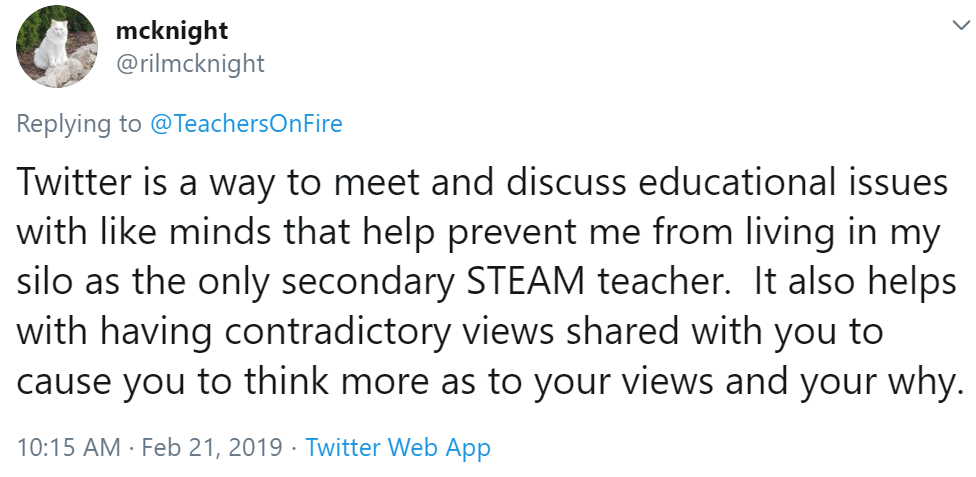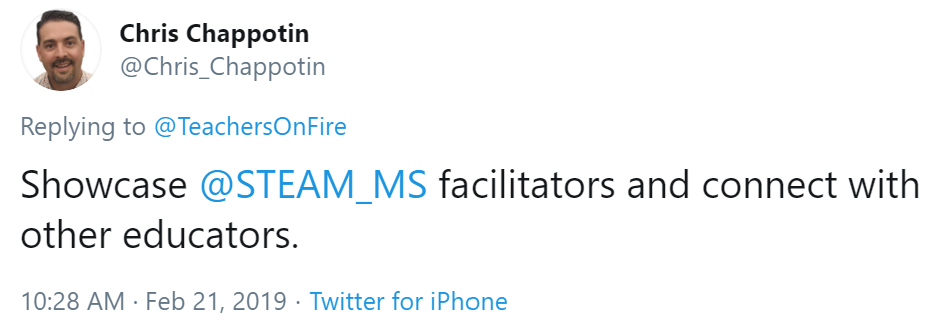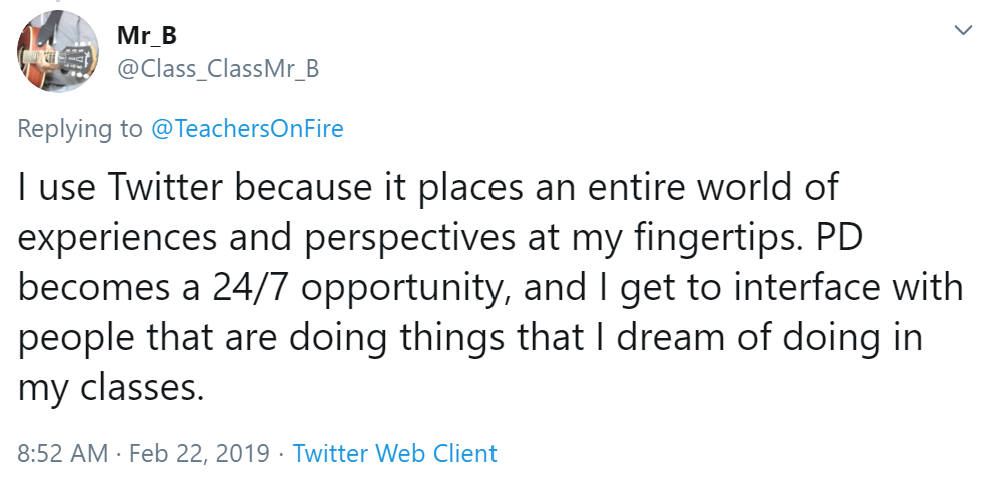Educators are learners first.

“I don’t care about Twitter, and I’ll never go on Twitter,” I heard an educator say last year.
I understand this position. From the outside, Twitter may just seem like more noise, more distraction, more nonsense that doesn’t really add anything to our lives or professional growth.
I’ll also be the first to agree that as busy professionals and leaders of families, we need to be intentional and discriminating with our time. Meaningless scrolling and shallow engagement doesn’t and shouldn’t make the cut.
But what IF Twitter can serve a valuable role in our professional growth and development? What IF Twitter can add to our lives without consuming much time?
Educators Are Learners First
In my view, the case for teachers on Twitter begins with the idea that educators are learners first. The principles of learning that we believe in for our students apply just as much to our learning and growth as they do to theirs. If we’re hungry to learn and grow, it’s wise to build an active Professional Learning Network and engage.
Twitter isn’t the only place to build a professional learning network. But it’s an awesome place to start.
The Learning Activities of a Twitter PLN
1. Collaboration.
Just like our students, education professionals learn best when they learn together. The whole really is greater than the sum of its parts. When you have a question or you’re feeling stuck in a challenging situation, chances are your Twitter PLN will be able to offer suggestions and resources.
2. Communication.
As David Guerin once wrote, “Whoever is doing the talking is doing the learning.” When we write, read, and respond to professional conversation, we’re more engaged. We’re tuned in. We can’t help but learn. And the inverse is also true.
3. Metacognition.
We also learn when we take the time to thoughtfully reflect on our journey. By answering questions like What am I learning, Where am I going, and How will I get there, we gain awareness and greater intentionality about our own learning path. I treat Twitter as a journal, especially when I’m trying a new project or attending an education conference. You too can use Twitter to archive and preserve your own learning reflections for future reference.
4. Visible Learning.
When we make our learning visible, we benefit from feedback, and others learn from our stories. And we can make the learning of others visible, too. When asked why he uses Twitter, principal Chris Chappotin used the word “showcase.” Administrators are especially well-positioned to play this role in their buildings, since they can be in more classrooms and contexts than teachers.
5. Inspiration.
Whether it’s a lesson idea, helpful resource, or a word of encouragement, my edu-Twitter feed is an overwhelmingly positive space. Think of it as constant connection with a cloud of education leaders and mentors. It’s phenomenal.
6. Professional Relationships.
When we engage in professional conversations, we meet others in similar fields and spaces. Twitter is a wonderful place to connect with education leaders and authors, too. It’s as easy as reaching out.
5 Ways to Increase Engagement on Twitter
I believe the number one reason that so many educators try Twitter and then ignore the platform is lack of engagement. Maybe it took them forever to work up the nerve to finally tweet something pithy or valuable, but it’s only crickets in response.
What a waste of time, right?
It doesn’t need to be. By following these five simple strategies, you’ll increase engagement and gain more value from your time on this platform.
1. Use relevant hashtags whenever possible.
If you’re new to the platform, you may regard hashtags as little more than cute decorations. But for many users (including me), hashtags can be a great way to dig deeper into a topic. Think of hashtags as rooms. Whenever you use a hashtag, you’re putting your tweet in that room for others to find. Whether it’s #growthmindset, #goinggradeless, or #formativeassessment, tag your posts so that others can find them topically. With a little Googling, you’ll find the best hashtags to use for your context and areas of work.
2. Tag others whenever appropriate or relevant.
If and when you’re sharing ideas or resources that relate to someone else’s work or area of interest, you’re doing them a service by tagging them. Educators usually like thoughtful tags — especially if it’s an endorsement, shoutout, suggestion, or recommendation aimed specifically at them. I always like being tagged by colleagues in my building, because otherwise I might miss their tweets. And authors usually appreciate being tagged in quotes from their work, because you’re helping to share their message. Again, keep it genuine. But don’t be afraid to connect.
3. Use relevant images, GIFs, and videos.
Make your tweets stand out and get noticed by adding relevant media. Again, this isn’t purely an attention game, but it is about building the kind of engagement on the platform that makes activity worthwhile. You have to be seen to be heard, especially as you get started.
4. Engage in Twitter chats.
There’s absolutely no better way to build connections with other educators than by engaging in real-time Twitter chats. Not sure where to start? Try the weekly #TLAP (Teach Like a Pirate) chat, one of the largest to take place on the platform each week. Or, next time you’re at a large conference, tweet the highlights from your learning at the conference hashtag.
5. Keep it education-only.
Make a point of only following educators, which generally keeps your feed on track with education. It’s incredibly easy to switch between Twitter accounts quickly, so I have my faith, sports, and politics conversations elsewhere. If you’re still not convinced, here are 5 Reasons to Niche Down on Twitter.
The point is, if you follow @RealDonaldTrump, @Yankees, @Netflix, and the like, your feed will get noisy, distracting, and unproductive. My advice? Keep it strictly on education.
A Simple Formula for Getting Started
There’s no time like the present to use Twitter to develop your professional learning. Once you’ve created a Twitter account, how can you go about building a professional learning network? Here are some practical steps.
- Start with at least one tweet a day.
- Share questions you’re wrestling with, ideas from your learning, or inspiring quotes from your reading.
- Use one or more relevant hashtags (like #MSed for middle school education).
- Use one or more user handles (think of interested colleagues, figures working in related areas, or authors of your quotes).
- Include relevant images whenever possible.
Then, try to follow at least one more educator a day. Not sure where to begin there? Visit @MisterCavey and select Following. You’ll see nothing but educators and education organizations. You can start following them, too.
As I said at the outset, Twitter can facilitate the same learning processes that we seek for our learners: communication, collaboration, creativity, critical thinking, metacognition, and relationships. If you’ve been a Twitter holdout, consider this both a challenge and an invitation.
Happy Tweeting! I look forward to learning with you.
Sincerely,
@MisterCavey
Thoughts from My Twitter PLN
As I put the finishing touches on this piece, I asked my PLN how they use Twitter. Here were some of their responses.
First, an educator who teaches in my area:

And here is a reply from Chris Chappotin, principal of STEAM Middle School and guest on episode 61 of the Teachers on Fire podcast, who I mentioned earlier in this story:

And this — from a fellow education podcaster:

Twitter changed my teaching life – when I joined almost a decade ago, I was the only AVID teacher, the only #edtech teacher, the only teacher ON Twitter in my school – and by doing exactly what you suggested I built a network of education professionals that have helped me grow and see parts of teaching, creating and communicating I never would have before. My feed is all mixed up with lots of follows – not purely education like yours – maybe one day I’ll clean it up and start another handle for all the other things I like to read about! Thanks for a great post – @mamawolfeto2
LikeLike
I can definitely relate, Jennifer! Twitter has changed my professional trajectory as well.
Yes, edu-only is awesome! Switching between handles is so fast and simple … you’ve got to give it a try some time.
Thanks SO much for reading and commenting.
LikeLike
Great info and ideas about using Twitter! Certainly a new educational perspective! Thanks!
LikeLike
Thanks so much for the comment, Michelle. Do you find that you’ve gained a lot from Twitter?
LikeLike
You’re welcome! I have gained quite a bit. Primarily it has come in the area of awareness of what colleagues are doing in the industry, and of course inspiration for my own personal growth.
LikeLike